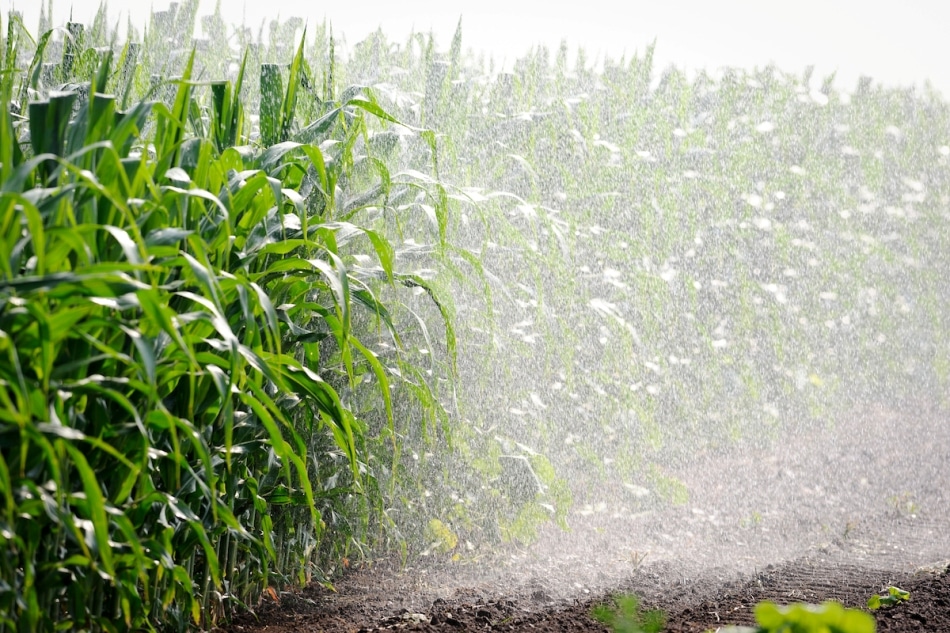Jul 3 2019
A new study has shown that irrigated farms within Wisconsin’s vegetable-growing Central Sands region considerably cool the local climate when compared to adjacent rainfed farms or forests.
 An irrigation system waters corn plants growing in a Wisconsin farm field. (Image credit: Jeff Miller)
An irrigation system waters corn plants growing in a Wisconsin farm field. (Image credit: Jeff Miller)
When compared to unirrigated farms or forests, irrigation decreased maximum temperatures by 1–3 °F on average and increased minimum temperatures up to 4 °F. Overall, irrigated farms experienced a three- to seven-degree smaller range in everyday temperatures than other land uses. These effects remained all year round.
The findings reveal that the conversion of land to irrigated agriculture can significantly affect the regional climate, which in turn can affect pest pressure, plant growth and human health in ways that could be ignored unless land uses are covered in planning and forecasts.
This kind of cooling effect reduces and obscures a global warming trend caused by the build-up of greenhouses gases in the air. Like all agriculture, irrigated farming also produces greenhouses gases.
The research was headed by Mallika Nocco, who recently finished her doctorate in the Nelson Institute for Environmental Studies at the University of Wisconsin–Madison, in collaboration with Christopher Kucharik of the Nelson Institute and the University of Wisconsin–Madison (UW–Madison) agronomy department and Robert Smail from the Wisconsin Department of Natural Resources.
The research team reported their discoveries on July 2nd, 2019, in the Global Change Biology.
We’re finding that weather forecasts can be wrong if they don’t take these land uses into account. That will affect both farmers and plants.
Mallika Nocco, Postdoctoral Researcher, University of Minnesota
Irrigation and agriculture in general cools the atmosphere owing to water evaporation through crop leaves—same as how sweating cools people. This evaporation also causes an increase in the water content of the atmosphere. The researchers desired to determine whether the naturally humid Wisconsin climate would react as strongly to irrigation as drier regions such as California do.
Nocco discovered this by working with private landowners to set up 28 humidity and temperature sensors in a line that crossed through the Central Sands. Measuring 37 miles, the transect extended from pine plantations in the west and over the irrigated farms toward forests in the east. The scientists obtained data over a period of 32 months, right from the beginning of 2014 through the summer of 2016.
All the 28 sensors were connected to nearby irrigation levels by a regional well withdrawal database controlled by Smail of the Department of Natural Resources.
Nocco’s research team discovered that irrigation decreased the maximum everyday temperature by nearly 3.5 °C when compared to neighboring rainfed farms. Nearby forests were somewhat warmer than irrigated or rain-fed farms.
Rather surprisingly, the lower maximum temperatures on the irrigated farms were followed by the higher minimum temperatures. Furthermore, saturated soils retain more heat than arid soils, which helps to maintain higher nighttime minimum temperatures to some extent when released at night. Wet soils might also be darker, helping them to absorb more sunlight during daytime.
The scientists discovered that when all land uses in the study area were transformed to irrigated farm, the day-to-day range in temperatures would decrease about 5 °F on average and up to 8 ° F at the high end. This minor difference between the daily minimum and maximum temperatures has a major impact on insect pest lifecycles and plant growth, both of which are susceptible to daily temperatures.
If you’re adjusting the range of temperatures, you’re changing who or what can live in an area.
Mallika Nocco, Postdoctoral Researcher, University of Minnesota
There were marked differences in temperature between rain-fed fields and irrigated fields, or forests during the growing season, when fields were being watered, but extended during the year. Although open fields of snow reflect more winter sunlight than forests do, maintaining the air above cooler, it is not completely clear what drives winter temperature differences between non-irrigated and irrigated farms.
Although the cooling effect of irrigation alleviates global climate change on the regional scale, climate models indicate that regional warming caused by global trend will slowly overcome the magnitude of mitigation provided by irrigated agriculture. At present, farmers are partially buffered against more extreme heat, but they would quickly face more stress in that case.
Farmers in irrigated regions may experience more abrupt temperature increases that will cause them to have to adapt more quickly than other groups who are already coping with a warming climate. It’s that timeframe in which people have time to adapt that concerns me.
Christopher Kucharik, Agronomy Department, Nelson Institute for Environmental Studies, UW–Madison
This study was the first to certainly connect irrigation in the Midwest U.S. to a changed regional climate. These study outcomes could help farmers plan better, enhance weather and climate forecasts, and, the scientists hope, better prepare agricultural areas to manage a warming climate when the irrigation effect is washed out.
“Irrigation is a land use with effects on climate in the Midwest, and we need to account for this in our climate models,” remarked Nocco.
This work was partially supported by the U.S. Environmental Protection Agency, the U.S. Department of Agriculture Sustainable Agriculture Research and Education Program, and the Wisconsin Department of Natural Resources.